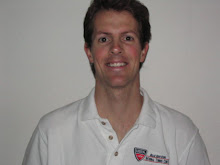Drills:
I start off with a broad coverage of ground strokes in general, without focusing too much on grips or types of spin which I break down into more detail later on.
There are some basic drills you can do depending on the level of the students. You can do a basic three balls across the baseline (drop down to two so they can run once they've warmed up), with the students lining up on the add side, moving towards the deuce court. This is a good drill for 5 or 6 players because it keeps them moving quickly. For smaller classes I like having the students line up in the middle and each student gets 2 forehand progressively further away from the center and then running back across for a wide backhand. I run through my progression and then switch to the backhand side, but that's personal preference.
Common Mistakes and Easy Corrections:
Obviously all students have a wide range of mistakes they make, especially depending on their level, but some of them are the same across the board. A few of the most common mistakes are:
1. Rushing
Most students don't realize they have much more time than they think. They run way too fast to the ball and end up jamming themselves. Have the student SLOW down their running, or even walk to a ball to get a feel for how much time they really have. Also swing slower!
2. Abbreviated Swings
A huge issue with people is how tight they get specifically if they're nervous. When a player gets tight he or she grips the racket way to tight which tightens the muscles in the arm which ends up abbreviating the swing. Have the student relax in the ready position and loosen up the grip on the racket. A looser arm creates the necessary racket acceleration.
3. Ball going in the wrong direction
First make sure the racket face is not at a crazy angle, pointing up to the roof or facing towards the ground (obviously it will face down a little bit for topspin but I'll discuss that more later), and second make sure the student is not swinging with his or her wrist. A lot of students, set the wrist back as they prepare and then flick their wrist during the swing. I see way too many students following through over their shoulder with a wrist fully bent in the wrong direction. This causes the ball to pull across the body. Remind the student the wrist remains set back throughout the swing.
Games:
Here are a couple of games to try out that focus on ground strokes. Students seem to enjoy "ping-pong" where the students are divided into 2 groups on either side of the net. They stand in a single file line and alternate hitting the ball. Person A on one side hits the ball and then goes to the back of the line so Person B will hit it when it comes back over, followed by Person C. Players D,E and F on the other side are also hitting one ball and going to the back of the line.
Another good running game is king of the court where there's a ruler on one side of the net and challengers on the other. The challenger has to hit a running forehand and then play out the point. If the challenger wins a set number of points (I keep it to 1 point to make it a faster moving game) he or she runs over and takes the king/queens spot.
The important thing is to be creative on the drills and games you play with students. I try and mix it up week to week so they don't tired of doing the exact same thing each class. If you're bored, chances are your students are too!



